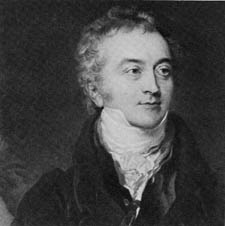Going back to the discussion of the retina, recall that there are two different kinds of receptor cells
in your eyes—rods and cones.
As we reminded you, the rods are responsible for achromatic
vision, or colorless vision.
The cones, on the other hand, are the receptors that
enable you to see colors.
Without them, you are color blind, whereas a problem
with one or two types of cones leads to a color deficiency.
Observations about additive color mixtures—e.
g.
, that the combination of just three primary colors
(Young suggested red, green, and blue) produces all the colors of the visual spectrum—led to the first major theory
of color vision.
This is the Young-Helmholtz, or trichromatic, theory.
(Trichromatic means three colors.
)

Thomas Young
1773-1829 |
In 1802, English physician and physicist Thomas
Young theorized that the perception of colors is caused by a pattern of stimulation of three different receptor types (cones)
in the eye.
For example, light reflected from a ripe banana
would cause little activation of “blue” receptors and approximately equal stimulation of “red” and
“green” receptors, causing us to perceive the banana as yellow.
|
